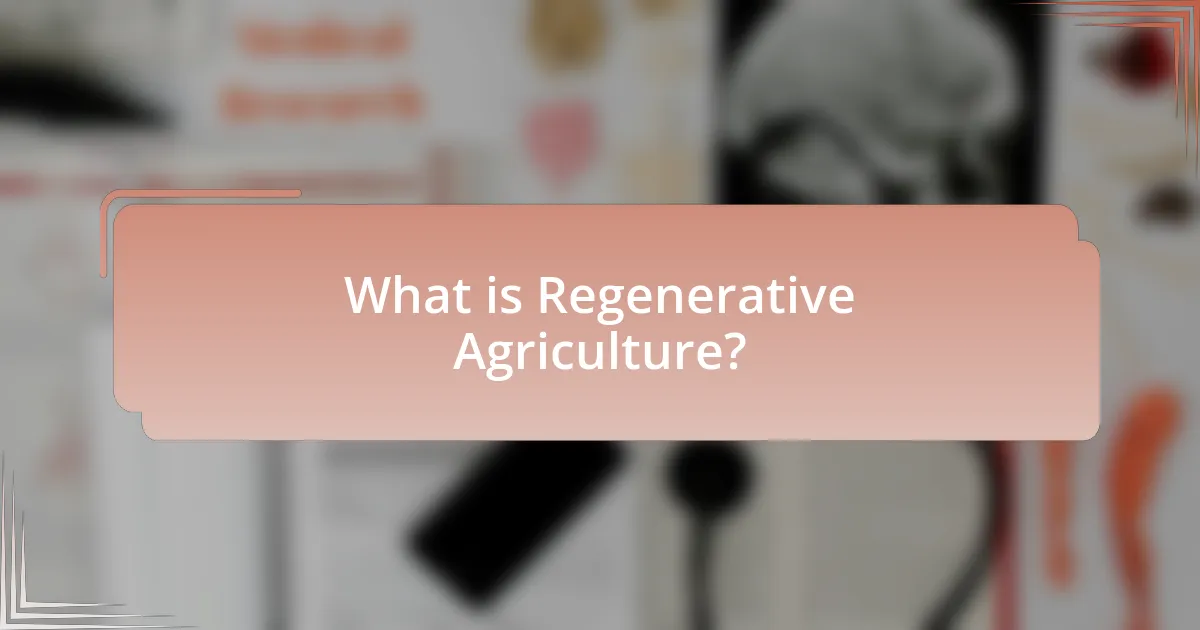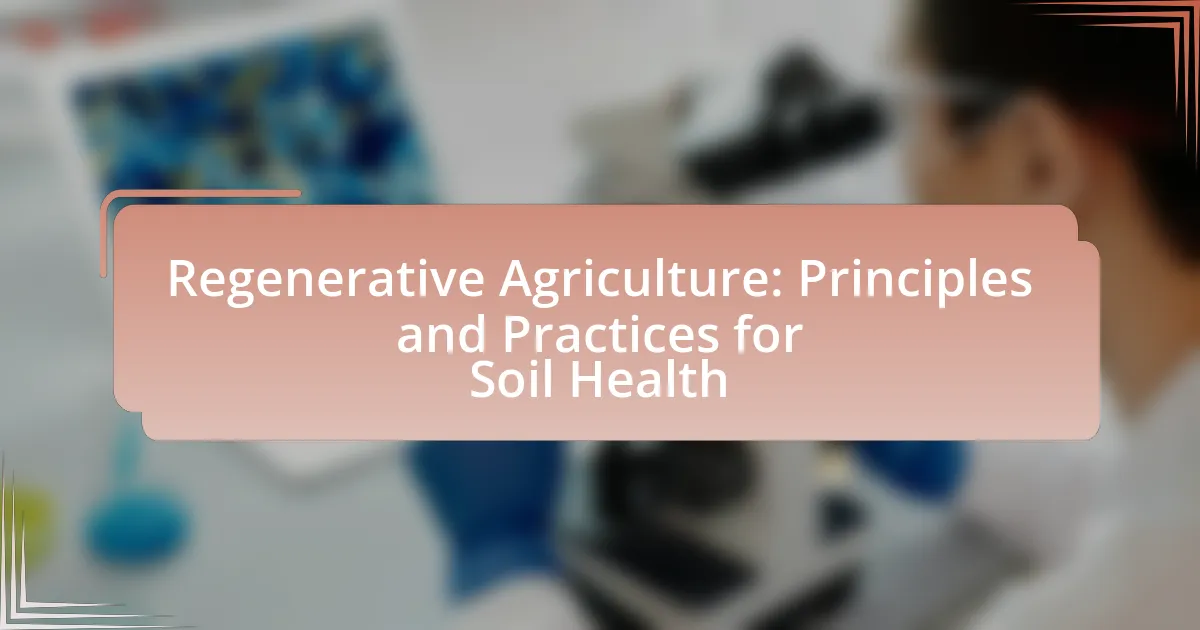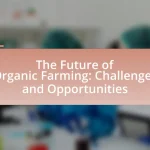Regenerative agriculture is a sustainable farming approach aimed at restoring soil health and enhancing biodiversity within agricultural ecosystems. This article outlines the principles and practices of regenerative agriculture, including cover cropping, crop rotation, and reduced tillage, which contribute to improved soil fertility, increased carbon sequestration, and reduced greenhouse gas emissions. Key goals of regenerative agriculture include enhancing soil health, promoting biodiversity, and integrating livestock with crop systems. The article also discusses the significance of soil health, the role of carbon sequestration, and the challenges farmers may face when transitioning to regenerative practices, along with strategies for successful implementation and community support.

What is Regenerative Agriculture?
Regenerative agriculture is a farming approach that focuses on restoring and enhancing the health and biodiversity of agricultural ecosystems. This method emphasizes practices such as cover cropping, crop rotation, agroforestry, and reduced tillage, which contribute to soil health, increase carbon sequestration, and improve water retention. Research indicates that regenerative agriculture can lead to a 30% increase in soil organic matter, which is crucial for nutrient cycling and soil fertility. Additionally, studies have shown that farms implementing regenerative practices can reduce greenhouse gas emissions by up to 50%, demonstrating its potential for climate change mitigation.
How does Regenerative Agriculture differ from conventional farming?
Regenerative Agriculture differs from conventional farming primarily in its focus on enhancing soil health and ecosystem resilience rather than maximizing short-term yields. Regenerative practices, such as cover cropping, crop rotation, and reduced tillage, aim to restore and maintain soil fertility, increase biodiversity, and sequester carbon, which contrasts with conventional farming’s reliance on synthetic fertilizers and monoculture that often deplete soil nutrients and harm ecosystems. Research indicates that regenerative methods can improve soil organic matter by 1-3% annually, leading to better water retention and reduced erosion, thereby providing a sustainable alternative to conventional practices that frequently result in soil degradation.
What are the key principles of Regenerative Agriculture?
The key principles of Regenerative Agriculture include enhancing soil health, promoting biodiversity, and integrating livestock and crop systems. Enhancing soil health is achieved through practices like cover cropping and reduced tillage, which improve soil structure and increase organic matter. Promoting biodiversity involves planting diverse crops and maintaining natural habitats, which supports ecosystem resilience and pest control. Integrating livestock with crops allows for nutrient cycling and improves land productivity. These principles are supported by research indicating that regenerative practices can lead to increased soil carbon sequestration and improved ecosystem services.
Why is soil health a central focus in Regenerative Agriculture?
Soil health is a central focus in Regenerative Agriculture because it directly influences ecosystem productivity, resilience, and sustainability. Healthy soil enhances nutrient cycling, water retention, and biodiversity, which are essential for robust agricultural systems. Research indicates that practices such as cover cropping, reduced tillage, and organic amendments improve soil structure and microbial activity, leading to increased crop yields and reduced dependency on chemical inputs. For instance, a study published in the journal “Agriculture, Ecosystems & Environment” by Teague et al. (2016) demonstrates that regenerative practices can restore soil health and sequester carbon, thereby mitigating climate change impacts.
What are the main goals of Regenerative Agriculture?
The main goals of Regenerative Agriculture are to restore soil health, enhance biodiversity, and improve ecosystem resilience. This approach focuses on practices that increase organic matter in the soil, such as cover cropping and reduced tillage, which can lead to improved water retention and nutrient cycling. Research indicates that regenerative practices can sequester carbon, thereby mitigating climate change effects, as evidenced by a study published in “Nature Sustainability” by authors including Teague et al., which highlights the potential for regenerative agriculture to sequester significant amounts of carbon in the soil.
How does Regenerative Agriculture contribute to biodiversity?
Regenerative agriculture contributes to biodiversity by enhancing soil health, which supports a diverse range of organisms. Practices such as crop rotation, cover cropping, and reduced tillage improve soil structure and fertility, leading to increased microbial diversity and abundance. Research indicates that regenerative practices can increase soil organic matter by 1-3% annually, which fosters habitats for various soil organisms, including beneficial insects and earthworms. Additionally, these practices promote a more resilient ecosystem by creating a balanced environment that supports both flora and fauna, ultimately leading to greater biodiversity on farms.
What role does carbon sequestration play in Regenerative Agriculture?
Carbon sequestration plays a crucial role in regenerative agriculture by enhancing soil health and mitigating climate change. This process involves capturing and storing atmospheric carbon dioxide in the soil, which improves soil structure, fertility, and biodiversity. Research indicates that practices such as cover cropping, reduced tillage, and agroforestry can increase soil organic carbon levels, thereby sequestering significant amounts of carbon. For instance, a study published in “Nature” by Paustian et al. (2016) found that regenerative agricultural practices could sequester up to 1.1 gigatons of carbon dioxide annually in the United States alone. This not only contributes to climate change mitigation but also promotes sustainable agricultural systems that are resilient and productive.

What practices are commonly used in Regenerative Agriculture?
Common practices used in Regenerative Agriculture include cover cropping, crop rotation, agroforestry, reduced tillage, and holistic grazing. Cover cropping enhances soil health by preventing erosion and improving nutrient cycling. Crop rotation disrupts pest and disease cycles while promoting biodiversity. Agroforestry integrates trees and shrubs into agricultural landscapes, which can enhance ecosystem services. Reduced tillage minimizes soil disturbance, preserving soil structure and microbial life. Holistic grazing management optimizes livestock grazing patterns to improve soil fertility and carbon sequestration. These practices collectively contribute to sustainable agricultural systems that restore and maintain soil health.
How do cover crops enhance soil health?
Cover crops enhance soil health by improving soil structure, increasing organic matter, and promoting biodiversity. These crops, such as clover and rye, prevent soil erosion and compaction while enhancing water retention and nutrient cycling. Research indicates that cover crops can increase soil organic carbon levels by 0.1 to 0.5% annually, which contributes to improved soil fertility and microbial activity. Additionally, they provide habitat for beneficial organisms, thus fostering a more resilient soil ecosystem.
What types of cover crops are most effective?
Leguminous cover crops, such as clover and vetch, are among the most effective types of cover crops. These crops enhance soil fertility by fixing nitrogen, improving soil structure, and suppressing weeds. Research indicates that leguminous cover crops can increase soil organic matter by up to 1.5 tons per acre annually, which significantly contributes to soil health and productivity. Additionally, non-leguminous cover crops like rye and oats are effective for erosion control and moisture retention, further supporting regenerative agriculture practices.
How do cover crops impact nutrient cycling?
Cover crops enhance nutrient cycling by improving soil structure, increasing organic matter, and promoting microbial activity. These plants capture and store nutrients, particularly nitrogen, which can be released back into the soil when they decompose. Research indicates that cover crops can reduce nutrient leaching by up to 50%, thereby retaining essential nutrients in the soil for subsequent crops. Additionally, the root systems of cover crops help to break up compacted soil, facilitating better water infiltration and nutrient uptake by plants. This process ultimately leads to improved soil fertility and health, supporting sustainable agricultural practices.
What is the significance of crop rotation in Regenerative Agriculture?
Crop rotation is significant in Regenerative Agriculture as it enhances soil health, increases biodiversity, and improves crop yields. By alternating different crops in a specific sequence, farmers can break pest and disease cycles, reduce soil erosion, and enhance nutrient cycling. Research indicates that crop rotation can lead to a 10-20% increase in crop yields compared to monoculture systems, as diverse root structures and plant types improve soil structure and fertility. Additionally, studies show that rotating legumes with other crops can fix nitrogen in the soil, reducing the need for synthetic fertilizers and promoting a more sustainable farming system.
How does crop rotation improve soil structure?
Crop rotation improves soil structure by enhancing soil aeration, moisture retention, and nutrient availability. Different crops have varying root structures; for example, deep-rooted plants like alfalfa can break up compacted soil layers, while shallow-rooted crops can help maintain surface soil integrity. This diversity in root systems promotes the formation of soil aggregates, which improves porosity and reduces erosion. Research indicates that fields practicing crop rotation show increased organic matter content and microbial activity, both of which contribute to better soil structure and health.
What are the benefits of diverse cropping systems?
Diverse cropping systems enhance agricultural resilience and productivity. They improve soil health by increasing organic matter, enhancing nutrient cycling, and promoting beneficial microbial activity. Research indicates that diverse systems can reduce pest and disease pressure, as varied crops disrupt the life cycles of pests and pathogens. For instance, a study published in the journal “Agriculture, Ecosystems & Environment” found that farms practicing crop diversity experienced a 30% reduction in pest populations compared to monoculture systems. Additionally, diverse cropping can lead to better water retention and reduced erosion, contributing to sustainable land management practices.

How can farmers implement Regenerative Agriculture practices?
Farmers can implement Regenerative Agriculture practices by adopting techniques such as cover cropping, crop rotation, reduced tillage, and integrating livestock into crop systems. Cover cropping improves soil health by enhancing organic matter and preventing erosion, while crop rotation disrupts pest cycles and improves nutrient cycling. Reduced tillage minimizes soil disturbance, preserving soil structure and microbial communities. Integrating livestock can enhance nutrient cycling through manure application and grazing management. Research indicates that these practices can lead to increased soil carbon sequestration, improved biodiversity, and enhanced resilience to climate change, as evidenced by studies showing that regenerative practices can increase soil organic carbon levels by up to 1.5 tons per hectare annually.
What are the first steps for transitioning to Regenerative Agriculture?
The first steps for transitioning to Regenerative Agriculture include assessing current farming practices, understanding soil health, and implementing cover cropping. Farmers should evaluate their existing methods to identify areas for improvement, focusing on soil biology and nutrient cycling. Research indicates that cover cropping can enhance soil structure, increase organic matter, and reduce erosion, which are essential for regenerative practices. According to a study published in the journal “Agronomy,” cover crops can improve soil health metrics significantly, demonstrating their effectiveness in regenerative agriculture.
How can farmers assess their current soil health?
Farmers can assess their current soil health by conducting soil tests, which measure key indicators such as pH, nutrient levels, organic matter content, and microbial activity. Soil testing provides quantitative data that helps farmers understand the nutrient availability and overall fertility of their soil. For instance, a study by the USDA Natural Resources Conservation Service indicates that regular soil testing can lead to improved crop yields and more efficient fertilizer use, ultimately enhancing soil health. Additionally, farmers can observe soil structure, moisture retention, and biodiversity as qualitative indicators of soil health.
What resources are available for farmers looking to transition?
Farmers looking to transition to regenerative agriculture can access a variety of resources, including educational programs, financial assistance, and technical support. Organizations such as the USDA offer programs like the Environmental Quality Incentives Program (EQIP), which provides financial assistance for implementing conservation practices. Additionally, universities and agricultural extension services provide workshops and training on regenerative practices, helping farmers understand soil health and sustainable farming techniques. Research institutions, such as the Rodale Institute, also offer resources and studies that demonstrate the benefits of regenerative agriculture, including improved soil health and increased crop yields.
What challenges might farmers face when adopting Regenerative Agriculture?
Farmers may face several challenges when adopting Regenerative Agriculture, including financial constraints, lack of knowledge, and resistance to change. Financially, the transition often requires upfront investments in new practices and technologies, which can be a barrier for many farmers. Additionally, a lack of knowledge about regenerative techniques can hinder effective implementation, as farmers may not be familiar with practices such as cover cropping or holistic grazing. Resistance to change is another significant challenge, as traditional farming methods are deeply ingrained, making it difficult for some farmers to shift their mindset and practices. These challenges are supported by studies indicating that financial and educational barriers are among the top reasons farmers hesitate to adopt regenerative practices.
How can farmers overcome financial barriers to transition?
Farmers can overcome financial barriers to transition by accessing grants, loans, and technical assistance specifically designed for regenerative agriculture. Various government programs, such as the USDA’s Environmental Quality Incentives Program, provide financial support to farmers adopting sustainable practices. Additionally, forming cooperatives can help farmers share resources and reduce costs associated with transitioning to regenerative methods. Research indicates that farmers who utilize these financial resources can significantly lower their initial investment risks, making the transition more feasible.
What are common misconceptions about Regenerative Agriculture?
Common misconceptions about regenerative agriculture include the belief that it is merely organic farming or that it cannot produce enough food to meet global demands. Regenerative agriculture goes beyond organic practices by focusing on soil health, biodiversity, and ecosystem restoration, which are not always prioritized in organic farming. Additionally, studies, such as those published in the journal “Nature Sustainability,” indicate that regenerative practices can enhance crop yields and resilience, challenging the notion that they are less productive. Another misconception is that regenerative agriculture is a new concept; in reality, many of its principles have been practiced for centuries by indigenous cultures and traditional farmers.
What are some best practices for successful Regenerative Agriculture?
Best practices for successful Regenerative Agriculture include implementing cover cropping, practicing crop rotation, and enhancing soil biodiversity. Cover cropping prevents soil erosion, improves soil structure, and enhances nutrient cycling, as evidenced by studies showing that cover crops can increase soil organic matter by up to 1% annually. Crop rotation disrupts pest and disease cycles, leading to healthier crops and reduced reliance on chemical inputs. Additionally, enhancing soil biodiversity through practices like reduced tillage and organic amendments fosters a resilient ecosystem, which has been shown to improve soil health indicators such as microbial activity and nutrient availability.
How can farmers monitor and evaluate their soil health over time?
Farmers can monitor and evaluate their soil health over time by utilizing soil testing, observing plant health, and implementing regular assessments of soil structure and biodiversity. Soil testing provides quantitative data on nutrient levels, pH, and organic matter content, allowing farmers to make informed decisions about amendments and management practices. Observing plant health, including growth patterns and pest resistance, serves as an indicator of soil vitality. Additionally, assessing soil structure through methods like the soil ribbon test and evaluating microbial activity can reveal changes in soil health. Research indicates that regular soil testing every 2-3 years can significantly enhance soil management strategies, leading to improved crop yields and sustainability.
What role does community support play in successful implementation?
Community support is crucial for the successful implementation of regenerative agriculture practices. It fosters collaboration among farmers, local organizations, and stakeholders, which enhances knowledge sharing and resource allocation. For instance, studies have shown that communities engaged in cooperative farming initiatives experience improved soil health and increased crop yields due to shared expertise and collective problem-solving. Additionally, community support can facilitate access to funding and technical assistance, as seen in programs like the USDA’s Conservation Stewardship Program, which encourages community involvement in sustainable practices. This collective effort not only strengthens the implementation process but also promotes long-term sustainability and resilience in agricultural systems.


